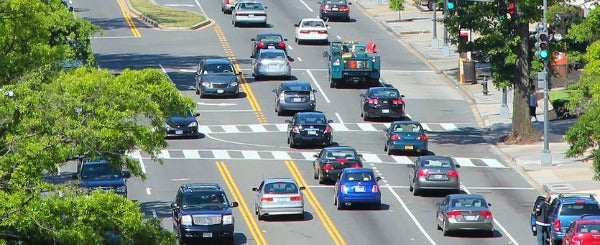
Since 2001, my businesses, Spack Consulting and Traffic Data Inc., have provided data collection and analysis throughout the Midwest. As portable video camera systems to collect traffic volume data has become mainstream in the last five years, my colleagues and I are not only collecting more hours of traditional turning movement counts for a lot less money, we’re also using this new technology to improve our engineering. Here are the Top 10 ways portable video data collection has changed and improved my engineering businesses.

-
More for Less
- Lower Mobilization Costs. Sending a technician out in a van with 20 camera systems to setup on a site two hours away is tremendously cheaper than sending 20-40 people out to do the manual turning movement counts on the ground.
- Avoid Bad Weather. We primarily work in “Minne-Snow’da.” We’ve had multiple projects where we’ve set up camera systems on Monday to record video on Tuesday and it ended up snowing on Tuesday. We just leave the camera systems out recording and use the video from Wednesday or Thursday instead of Tuesday. No headaches with rescheduling crews to do the manual counts. We’ve also had similar situations to avoid rain. In recreation areas with high pedestrian crossings, we’ve left the cameras out and counted video from the day with the nicest weather.
- Cheap to do Weekend Counts. It’s expensive to mobilize a count from 7 p.m. to 2 a.m. on a Friday night by a casino or on Sunday morning by a church. We set up cameras on Wednesday and record Thursday through Sunday to get normal weekday and special weekend conditions, counting just the hours that are needed.
- Count Turns Only. When doing a corridor study, we’ll do full counts at key intersections but just count the turns at minor intersections. The full count data from the adjacent intersections are used to calculate the through volumes at the minor intersections. This is especially cost effective for signal re-timing projects.
- Hone In On the Peak Hour. Likewise, we do studies where we’ll do 13 or 24 hour counts at key intersections and then do one hour peak counts at minor intersections based on the full data.
- Why do we still do 2 Hour Turning Movement Counts? Sometimes we make million dollar decisions (or even billion dollar decisions) that have a single data point at their foundation. A $900 COUNTcam MINI that can record for 50 hours combined with a $240 price to process a 48 hour count from your video using the COUNTcloud service have driven the costs so low for turning movement counts that we have no excuse to still be doing 2 hour counts as the standard.
- Avoid Placing Tube Counters. 48 hour turning movement counts provide peak hour turning movement count data, but also provide Average Daily Traffic volumes on all legs of the intersection that we would have historically been collected using tube counters.
-
Have an Archive
- We all get data back that looks incorrect. Doing spot checks or even complete recounts from video you already have typically costs 90% less than the old method of sending a person out in the field to completely redo the count.
- Engineer Can Scan the Video. Scrolling through the video of the intersections helps give context to the data.
- Multiple Engineers. At Traffic Data Inc., we deliver the videos with the count data. This provides many of the benefits discussed in this paper to our consulting engineer clients. We’ve also provided the videos to government agency engineers when they request it. Providing the video along with the count data gives our clients along with their customers the opportunity to review and take a closer look the traffic flows for their project.
-
Less Assumptions
- Warrant Analyses. Historical practice in Minnesota is to place tube counters on the approaches at an intersection to get the hourly data needed for all way stop or signal warrant analyses per the MUTCD. Two hour a.m. and p.m. turning movement counts would be collected and the hourly tube volume data would be adjusted based on the turning movement count data to reduce for right turning volumes per MnDOT’s estimating policy. Now, we just do a 48 hour turning movement count and take out a portion of the actual right turns out of the data.
- Collect Trip Generation Data. ITE recommends collecting current, localized trip generation data whenever possible. This has rarely happened though – the vast majority of engineers just use the average rates out of the Trip Generation Manual. Now that the ins/outs can be counted at access points by viewing the video at 20x speed, we’ve been collecting thousands of hours of trip generation data to use in our traffic impact studies.
- Why Guess at the Peak Hour? We’ve all had two hour counts where the last 60 minutes are the peak hour. With video, you can add on 15 or 30 minutes to your count to confirm that your 60 minutes are in fact the peak hour or shift to the slightly later peak hour. This is becoming irrelevant in Minnesota though as a 6 a.m. to 7 p.m. has become the new standard.
-
Do Research
- Drive-Through Queue Generation 1.0. How much storage is needed in a drive through? We collected 1,200+ hours of video at banks, pharmacies, fast food restaurants, car washes and coffee shops. You can read our complete report and see all of the data/statistics in our drive-through queue article How Many Vehicles Do you Need to Store in a Drive Through Lane?
- Effectiveness of Travel Demand Management. How much does a well implemented Travel Demand Management Plan reduce traffic at a business? We collected 600+ hours at nine office complexes. We use trip generation and parking generation reductions in our Traffic Impact Studies based on this data. You can read the complete report and see all of the data/statistics in our article Documenting the Effectiveness of Travel Demand Management Measures.
-
Calibration
- Micro-Simulation Calibration. We conducted a traffic impact study for a gravel mine expansion that was complicated by an active rail line less than a hundred feet from the main access on a state highway. Read the full case study at Trainspotting – Modelling Gravel Trucks Through a Train Crossing.
- Models vs. Real World. How do you calibrate to something that doesn’t exist? How do you take an existing all way stop sign controlled intersection and calibrate to increased traffic forecasts with traffic signal or roundabout control at an intersection? We collected hundreds of hours of video and extracted queuing and delay data at existing intersections. Then models were built using different software programs with their input defaults to determine which models best matched the real world queuing and delay data. We presented our results to both the North Central ITE section and the Oregon SimCap group. You can read more and see our presentation at Which Traffic Simulation Software is Best? (Phase 1) and Which Traffic Simulation Software is Best? (Phase 2)
- Test Traffic Counting Equipment. Video systems have been used to verify the accuracy of loop detectors, tube counters, microwave detectors, and several styles of pedestrian/bicycle counters.
